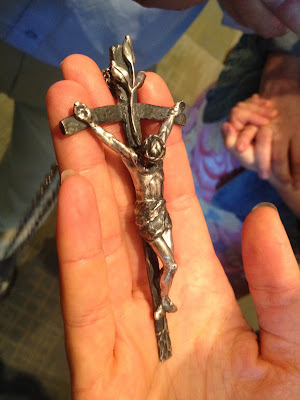The signet area shows a communion chalice surrounded by the flame of the Holy Spirit. A sword symbolizing the Word of God is wrapped around the band. In this picture you only see the handle of the sword. The three symbols were chosen by the bishop to represent the core of his ministry, and it was my job to pull them together into some kind of design.
I did not want this piece to communicate worldly power or opulence, but there were moments during its making when it was moving in that direction. I tried to keep it from looking like a rich man's ring by giving it an irregular, handmade, time softened look inspired by this ancient ring.
 |
| http://commons.wikimedia.org/wiki/File:Byzantine_-_Signet_Ring_-_Walters_572104_-_View_B.jpg |
The bishop-to-be wanted the piece to communicate not only the suffering and labor of Jesus on the cross, but His victory. My initial ideas for communicating that victory, such as a sunburst radiating from the cross, looked more decorative than specifically symbolic. I feared that I would not be able to come up with anything I felt good about, but one day as I was in my car running errands, pondering and praying for insight, I knew that the cross itself should burst into life like Aaron's rod (Numbers 17:8). My first mental image was of tiny branches budding and blooming all over the cross, but the visual statement was weak and confusing at that scale, so I settled on a simpler design, with a root at the bottom, a stem running the length of the cross, and a few leaves at the top--"a shoot from the stump of Jesse." (Isaiah 11:1)
The hardest work was carving the figure of Jesus. I didn't try to create a harshly realistic image of crucifixion, but a truth-telling symbol that expresses both suffering and love. I would like to have had a year to study anatomy and crucifixes through the centuries, but instead I took a few weeks to look at a lot of crucifixes and crucifixion paintings online and make a lot of practice pieces in clay. The artistic director of this project was a sculptor with amazing knowledge of anatomy. His input was invaluable.
I don't much like this photograph, partly because I designed this piece to be seen from the front, and the side views or three quarters views are distorted or compressed to make the piece work as jewelry. When I get better pictures I'll update this post. I wish I had taken pictures of the finished wax crucifix, which now sadly is no more, having been melted away in the casting process. We were super busy with a bunch of stuff during that time and missed the chance.



No comments:
Post a Comment